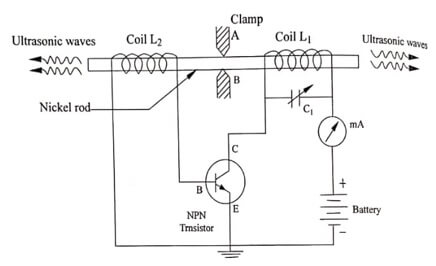The principle of magnetostriction oscillator method is magnetostriction effect. When a bar of ferromagnetic material like Ni ,Co, and Fe etc., is placed in an alternating magnetic field parallel to its length ,it undergoes slight changes in its length. The phenomenon is known as ‘Magnetostriction effect’.
The change in length (increase (or) decrease) of the rod depends upon the strength of the magnetic field and nature of the material. This effect was discovered by James Joule in 1842.
Principle
Magnetostriction effect is the principle of producing ultrasonic waves. (i.e.) when an alternating magnetic field is applied to a rod of ferromagnetic material such as nickel, iron, cobalt etc., the rod expands and contracts in length for each half cycle of alternating current. This results in the vibrations of the rod as shown in Fig.1.1 thereby producing ultrasonic waves at resonance.

Fig. 1.1 Magnetostriction effect
Construction
The magnetostriction oscillator consists of nickel rod which is clamped in the middle between two knife edges A and B. A coil L1 wound on the right hand portion of the rod forms the resonant circuit with variable capacitor C1 for the collector tuned oscillator. Another coil L2 is wound on the left hand portion of this rod which is connected in the base circuit. The coil L2 is used as a feedback loop.

Fig 1.2 Magnetostriction oscillator
Working
- When the battery is switched on, a current flows through the oscillatory circuit.
- Due to presence of capacitor an (A.C) field is set up on the nickel rod and the coil L1 provides an alternating magnetic field along the length of the rod.
- The result is that the rod starts vibrating due to the magnetostriction effect.
- The vibrations of the rod creates ultrasonic waves which are sent out.
- The longitudinal expansion and contraction of the rod, produces an emf in the coil L2 which is applied to the base of transistor which increases the amplitude of high frequency oscillations in coil L1 due to positive feed back.
| Read More Topics |
| Architectural acoustics |
| Lightning arrester or lightning conductor |
| Tangent law and tangent galvanometer |





